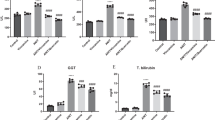Summary
In previous studies, we have suggested that the selective inhibitory effect of sodium cyanate (NaOCN) on hepatoma metabolism may be due to the lower pH observed in tumors relative to normal tissues. Lower pH might enhance the action of NaOCN by increasing the formation of isocyanic acid and carbamoylation of sulfhydryl groups. In the present work, studies were conducted on the effect of pH on the carbamoylation of sulfhydryl groups. The data indicated that carbamoylation of the sulfhydryl group of glutathione by NaOCN was enhanced by decreasing the pH from 7.4 to 6.6. A less pH-dependent response was observed with organic isocyanates. However, all reactions were reversible after the pH was increased by the addition of base. Kinetic studies showed that the rate of the reaction is very rapid, a maximal effect occurring within the first 10 min. Dose-dependent modifications of cellular glutathione by NaOCN and organic isocyanates were observed in human HT29 colon tumor cells, rat HTC hepatoma cells, and rat hepatocytes. The rate of carbamoylation of the glutathione sulfhydryl group in cells was similar to that of pure glutathione (GSH). The effect of buthionine sulfoximine on GSH levels in cells was at least as great as that of sodium cyanate, but only the latter showed inhibitory effects on macromolecular synthesis; these were very rapid, pH-dependent, and reversible in tumor cells. Our results suggest that cellular sulfhydryl group(s) other than that of GSH might be involved in the effect of NaOCN on macromolecular synthesis.
Similar content being viewed by others
References
Alexander NM (1958) Spectrophotometric assay for sulfhydryl groups using N-ethylmaleimide. Anal Chem 30: 1292
Arrick BA, Nathan CF (1984) Glutathione metabolism as a determinant of therapeutic efficacy: a review. Cancer Res 44: 4224
Babson JR, Reed DJ (1978) Inactivation of glutathione reductase by 2-chloroethyl nitrosourea derived isocyanates. Biochem Biophys Res Commun 83: 754
Babson JR, Abell NS, Reed DJ (1981) Protective role of the glutathione redox cycle against Adriamycin-mediated toxicity in isolated hepatocytes. Biochem Pharmacol 30: 2299
Begleiter A, Grover J Froese E, Goldenberg GJ (1983) Membrane transport, sulfhydryl levels and DNA cross-linking in Chinese hamster ovary cell mutants sensitive and resistant to melphalan. Biochem Pharmacol 32: 293
Carreras J, Chabas A, Diederich D (1976) Physiological and clinical implications of protein carbamoylation. In: Grisolia S, Baguena R, Mayor F (eds) The urea cycle John Wiley & Sons, New York, p 501
Fisher JM, Nauzokaitis AS, Uehara Y, Rabinovitz M (1983) Evidence for a membrane sulfhydryl associated with resistance to melphalan in a murine L1210 leukemia line. Biochem Biophys Res Commun 117: 670
Freedman ML, Schiffman FJ, Geraghty M (1974) Studies on the mechanism of cyanate inhibition of reticulocyte protein synthesis. Br J Haematol 27: 303
Glader BE, Conrad ME (1972) Cyanate inhibition of erythrocyte glucose-6-phosphate dehydrogenase. Nature 237: 336
Griffith OW (1980) Determination of glutathione and glutathione disulfide using glutathione reductase and 2-vinylpyridine. Anal Biochem 106: 207
Gullino PM (1966) The internal milieu of tumors. Prog Exp Tumor Res 8: 1
Herrera-Ornelas L, Petrelli NJ, Madajewicz S, Mittelman A, Allfrey VG (1985) Phase-I clinical trial of sodium cyanate in patients with advanced colorectal carcinoma. Oncology 42: 236
Hu JJ, Luke A, Chellani M, Zirvi KA, Lea MA (1988) pH-related effects of sodium cyanate on macromolecular synthesis and tumor cell division. Biochem Pharmacol 37: 2256
Lea MA (1983) Decreased sensitivity to colchicine-mediated inhibition of metabolite uptake in isolated hepatoma cells. J Natl Cancer Inst 71: 1073
Lea MA (1987) Effects of carbamoylating agents on tumor metabolism. Crit Rev Oncol Hemotol 7: 329
Machiedo G, Ghuman S, Rush BF, Draven T, Dikdan G (1981) The effect of ATP-MgCl2 infusion on hepatic cell permeability and metabolism following hemorrhagic shock. Surgery 90: 328
Rotin D, Wan P, Grinstein S, Tannock I (1987) Cytotoxicity of compounds that interfere with the regulation of intracellular pH: a potential new class of anticancer drugs. Cancer Res 47: 1497
Russo A, Carmichael J, Friedman N, Degraff W, Tochner Z, Glatstein E, Mitchell JB (1986) The roles of intracellular glutathione in antineoplastic chemotherapy. Int J Radiat Oncol Biol Phys 12: 1347
Shaw JP, Chou I-N (1986) Elevation of intracellular glutathione content associated with mitogenic stimulation of quiescent fibroblasts. J Cell Physiol 129: 193
Stark GR (1964) On the reversible reaction of cyanate with sulfhydryl groups and the determination of NH2-terminal cysteine and cysteine in proteins. J Biol Chem 239: 1411
Stark GR (1967) Modification of proteins with cyanate. In: Hirs CHW, Timashef SN (eds) Methods in enzymology, vol 11. Academic, New York, p 590
Tew KD, Kyle G, Johnson A, Wang AL (1985) Carbamoylation of glutathione reductase and changes in cellular and chromosome morphology in a rat cell line resistant to nitrogen mustards but collaterally sensitive to nitrosoureas. Cancer Res 45: 2326
Tew KD, Woodworth A, Stearns ME (1986) Relationship of glutathione depletion and inhibition of glutathione-S-transferase activity to the antimitotic properties of estramustine. Cancer Treat Rep 70: 715
Wike-Hooley JL, Haveman J, Reinhold HS (1984) The relevance of tumour pH to the treatment of malignant disease (review article). Radiother Oncol 2: 343
Wolf CR, Lewis AD, Carmichael J, Adams DJ, Allan SG, Ansell DJ (1987) The role of glutathione in determining the response of normal and tumor cells by depletion of intracellular glutathione. Science 217: 544
Author information
Authors and Affiliations
Rights and permissions
About this article
Cite this article
Hu, J.J., Dimaira, M.J., Zirvi, K.A. et al. Influence of pH on the modification of thiols by carbamoylating agents and effects on glutathione levels in normal and neoplastic cells. Cancer Chemother. Pharmacol. 24, 95–101 (1989). https://doi.org/10.1007/BF00263127
Received:
Accepted:
Issue Date:
DOI: https://doi.org/10.1007/BF00263127




